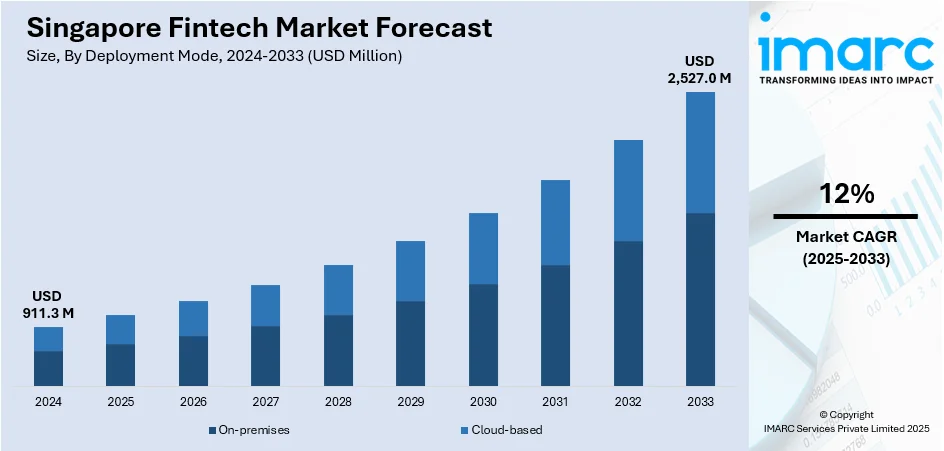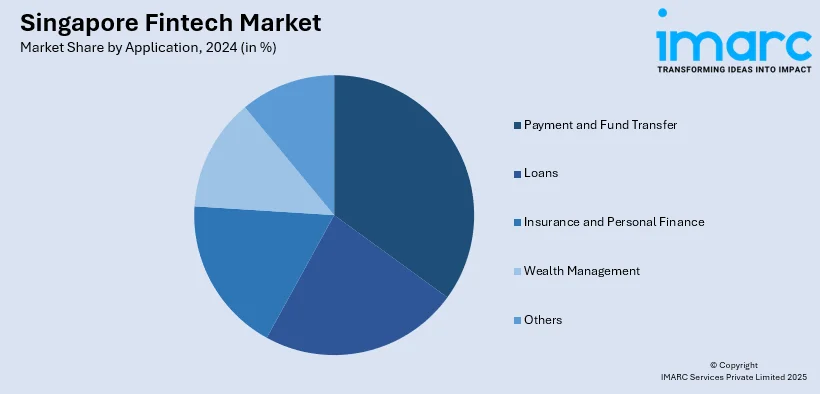
Singapore Fintech Market Size, Share, Trends and Forecast by Deployment Mode, Technology, Application, End User, and Region, 2025-2033
Singapore Fintech Market Overview:
The Singapore fintech market size reached USD 911.3 Million in 2024. Looking forward, IMARC Group expects the market to reach USD 2,527.0 Million by 2033, exhibiting a growth rate (CAGR) of 12% during 2025-2033. The robust government support, increasing consumer demand for digital financial services, strong investment inflows, advanced digital infrastructure, and a highly skilled workforce are some of the major factors propelling the growth of the market.
|
Report Attribute
|
Key Statistics
|
|---|---|
|
Base Year
|
2024 |
|
Forecast Years
|
2025-2033 |
|
Historical Years
|
2019-2024
|
| Market Size in 2024 | USD 911.3 Million |
| Market Forecast in 2033 | USD 2,527.0 Million |
| Market Growth Rate (2025-2033) | 12% |
Singapore Fintech Market Trends:
Government Support and Regulation
Robust government initiatives and a favorable regulatory environment foster innovation and growth in the fintech sector. For instance, the Singapore FinTech sector continues to evolve and grow and is a strong driver of economic growth and financial sector evolution. In late 2022, Mr. Lawrence Wong, Singapore's Deputy Prime Minister and Minister for Finance and Deputy Chairman of the Monetary Authority of Singapore (MAS) launched a refreshed Financial Services Industry Transformation Map (ITM) 2025. This ITM renews emphasis on FinTech start-up areas. Singapore is an open and global FinTech centre and sustained growth is expected in the FinTech sector despite a slight dip in FinTech funding in 2022 as compared to 2021.

To get more information on this market, Request Sample
Advanced Digital Infrastructure
Singapore's state-of-the-art digital infrastructure supports the seamless integration and scalability of fintech solutions. For instance, in March 2024, an inter-agency Taskforce on the Resilience and Security of Digital Infrastructure and Services (“Taskforce”), led by the Ministry of Communications and Information, announced its plans to introduce a new Digital Infrastructure Act (“DIA”) to bolster the resilience and security of key digital infrastructure and services in Singapore. The DIA will complement various other regulatory measures, including the upcoming amendments to the Cybersecurity Act 2018. The DIA is being drafted at present and it is likely to have an impact on digital infrastructure and service providers (e.g. telecommunication service providers, cloud service providers and data center operators).
Strong Investment Inflows
Significant venture capital and investment inflows into the fintech industry enhance development and expansion opportunities. For instance, in May 2023, SeaTown Private Capital Master Fund was overseen by SeaTown Holdings International, an Asia-focused investment enterprise owned by Seviora, the asset management division of Singapore’s state-owned investment firm, Temasek. Linnovate offers asset servicing and fund administration solutions for the investment industry. It says its proprietary, cloud-based platform RAISE offers “all the functions of alternative investing in a single ecosystem”. The firm claims it administers over $130 billion in assets across more than 600 private equity and venture capital funds.
Singapore Fintech Market News:
- In May 2024, to help navigate an increasingly complex macroeconomic landscape and support the overseas expansion of Singapore FinTechs, the SFA announced that they will form a Strategic Advisory Council to advise SFA and the FinTech community on key issues and to advance the interests of the FinTech community in Singapore.
- In February 2023, Workforce Singapore (WSG) and Singapore FinTech Association (SFA) launched the FinTech Talent Programme (FTP), the first attach-and-train Career Conversion Programme (CCP) in the industry.
Singapore Fintech Market Segmentation:
IMARC Group provides an analysis of the key trends in each segment of the market, along with forecasts at the country level for 2025-2033. Our report has categorized the market based on deployment mode, technology, application, and end user.
Deployment Mode Insights:
- On-premises
- Cloud-based
The report has provided a detailed breakup and analysis of the market based on the deployment mode. This includes on-premises and cloud-based.
Technology Insights:
- Application Programming Interface
- Artificial Intelligence
- Blockchain
- Robotic Process Automation
- Data Analytics
- Others
A detailed breakup and analysis of the market based on the technology have also been provided in the report. This includes application programming interface, artificial intelligence, blockchain, robotic process automation, data analytics, and others.
Application Insights:

- Payment and Fund Transfer
- Loans
- Insurance and Personal Finance
- Wealth Management
- Others
The report has provided a detailed breakup and analysis of the market based on the application. This includes payment and fund transfer, loans, insurance and personal finance, wealth management, and others.
End User Insights:
- Banking
- Insurance
- Securities
- Others
A detailed breakup and analysis of the market based on the end user have also been provided in the report. This includes banking, insurance, securities, and others.
Regional Insights:
- North-East
- Central
- West
- East
- North
The report has also provided a comprehensive analysis of all the major regional markets, which include North-East, Central, West, East, and North.
Competitive Landscape:
The market research report has also provided a comprehensive analysis of the competitive landscape in the market. Competitive analysis such as market structure, key player positioning, top winning strategies, competitive dashboard, and company evaluation quadrant has been covered in the report. Also, detailed profiles of all major companies have been provided.
Singapore Fintech Market Report Coverage:
| Report Features | Details |
|---|---|
| Base Year of the Analysis | 2024 |
| Historical Period | 2019-2024 |
| Forecast Period | 2025-2033 |
| Units | Million USD |
| Scope of the Report | Exploration of Historical Trends and Market Outlook, Industry Catalysts and Challenges, Segment-Wise Historical and Future Market Assessment:
|
| Deployment Modes Covered | On-premises, Cloud-based |
| Technologies Covered | Application Programming Interface, Artificial Intelligence, Blockchain, Robotic Process Automation, Data Analytics, Others |
| Applications Covered | Payment and Fund Transfer, Loans, Insurance and Personal Finance, Wealth Management, Others |
| End Users Covered | Banking, Insurance, Securities, Others |
| Regions Covered | North-East, Central, West, East, North |
| Customization Scope | 10% Free Customization |
| Post-Sale Analyst Support | 10-12 Weeks |
| Delivery Format | PDF and Excel through Email (We can also provide the editable version of the report in PPT/Word format on special request) |
Key Benefits for Stakeholders:
- IMARC’s industry report offers a comprehensive quantitative analysis of various market segments, historical and current market trends, market forecasts, and dynamics of the Singapore fintech market from 2019-2033.
- The research report provides the latest information on the market drivers, challenges, and opportunities in the Singapore fintech market.
- Porter's five forces analysis assist stakeholders in assessing the impact of new entrants, competitive rivalry, supplier power, buyer power, and the threat of substitution. It helps stakeholders to analyze the level of competition within the Singapore fintech industry and its attractiveness.
- Competitive landscape allows stakeholders to understand their competitive environment and provides an insight into the current positions of key players in the market.
Key Questions Answered in This Report
The fintech market in Singapore was valued at USD 911.3 Million in 2024.
The Singapore fintech market is projected to exhibit a CAGR of 12% during 2025-2033, reaching a value of USD 2,527.0 Million by 2033.
Singapore fintech market thrives on strong government support, a favorable regulatory environment, and a tech-savvy population. Key drivers include widespread adoption of digital payments, rapid growth in the blockchain and Web3 sectors, and strategic positioning as a regional hub for Southeast Asia. Robust digital infrastructure and initiatives like the Financial Sector Technology and Innovation (FSTI) scheme further bolster innovation and attract global fintech players.
Need more help?
- Speak to our experienced analysts for insights on the current market scenarios.
- Include additional segments and countries to customize the report as per your requirement.
- Gain an unparalleled competitive advantage in your domain by understanding how to utilize the report and positively impacting your operations and revenue.
- For further assistance, please connect with our analysts.
 Request Customization
Request Customization
 Speak to an Analyst
Speak to an Analyst
 Request Brochure
Request Brochure
 Inquire Before Buying
Inquire Before Buying




.webp)




.webp)












